Technology to Support a Healthy Future for Newborns
Developing a New Technique for the Early Detection of Inherited Metabolic Disorders

Shimadzu engages in a variety of research and development aimed at promoting the health of people and supporting safer living in collaboration with partners. This article presents a technology advancement in newborn screening for inherited metabolic disorders.
- What are Inherited Metabolic Disorders?
- Analyze Blood Samples to Check for Hidden Inherited Metabolic Disorders Using Tandem Mass Spectrometry
- The Long-Standing Challenge – False Positives
- Eliminating False Positives in a Single Step
- Achieving SDG “Good Health and Well-Being”
- Message from the Person in Charge of Development for Newborn Screening Method
What are Inherited Metabolic Disorders?
Inherited metabolic disorders are genetic illnesses caused by congenital enzyme defects. Babies with such disorders might show no symptoms at birth, but if left untreated, they may become symptomatic, and may later suffer serious health problems, neurological impairments or even death.
Such symptoms can be prevented with appropriate treatment like dietary therapy or drugs. Early detection and intervention of such patients using newborn screening help ensure a healthy future for babies.
Analyze Blood Samples to Check for Hidden Inherited Metabolic Disorders Using Tandem Mass Spectrometry
One of the screening methods to detect such metabolic disorders uses tandem mass spectrometry. Mass spectrometers are systems that ionize a target substance, identify the specific substances, then determine the amounts of such substances in the extremely small samples like dried blood filter paper.
This type of analysis is performed using an extremely small volume of blood collected from newborns within one week of birth and looks for ions of specific metabolites indicative of disease to determine those metabolites in the sample. This data can then indicate the presence of a potential metabolic disorder. First developed in the U.S. in the 1990s, newborn screening by tandem mass spectrometry has been growing in popularity in Europe, the U.S., and Asia since around 2000.
Shimadzu has collaborated with Seiji Yamaguchi, Visiting Professor at the Department of Pediatrics, Shimane University School of Medicine, in developing a quicker and simpler tandem mass spectrometry-based screening method. This method can be used with tandem mass spectrometers to screen for 20 or more potential diseases simultaneously. In Japan, almost 100% of babies undergo newborn screening using tandem mass spectrometry.
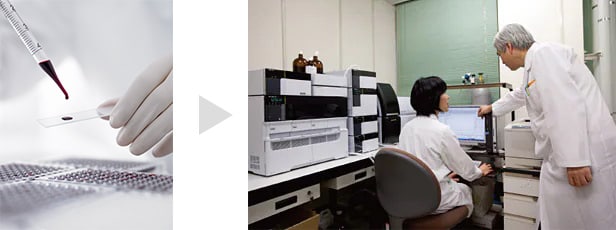
Using a mass spectrometer to measure markers in blood
The Long-Standing Challenge – False Positives
False positive results for isovaleric acidemia have been a long-standing challenge associated with the increasing use of screening tests.
Early accurate diagnosis of isovaleric acidemia is important as the disease causes vomiting, impaired consciousness, and neurological impairments in early infancy.
Isovaleric acidemia is detected by measuring isovaleryl carnitine (i-C5) levels in the blood. However, antibiotic use by the mother or baby increases levels of pivaloyl carnitine (p-C5) in the blood, which has the same mass as i-C5. Tandem mass spectrometry has difficulty distinguishing between substances of the same mass, leading to false positives for isovaleric acidemia in healthy babies caused by the detection of p-C5.
For this reason, a positive result requires additional testing, which is physically stressful for the baby and psychologically stressful for the family. The development of methods to prevent the false positives may be essential both for the babies and their families.
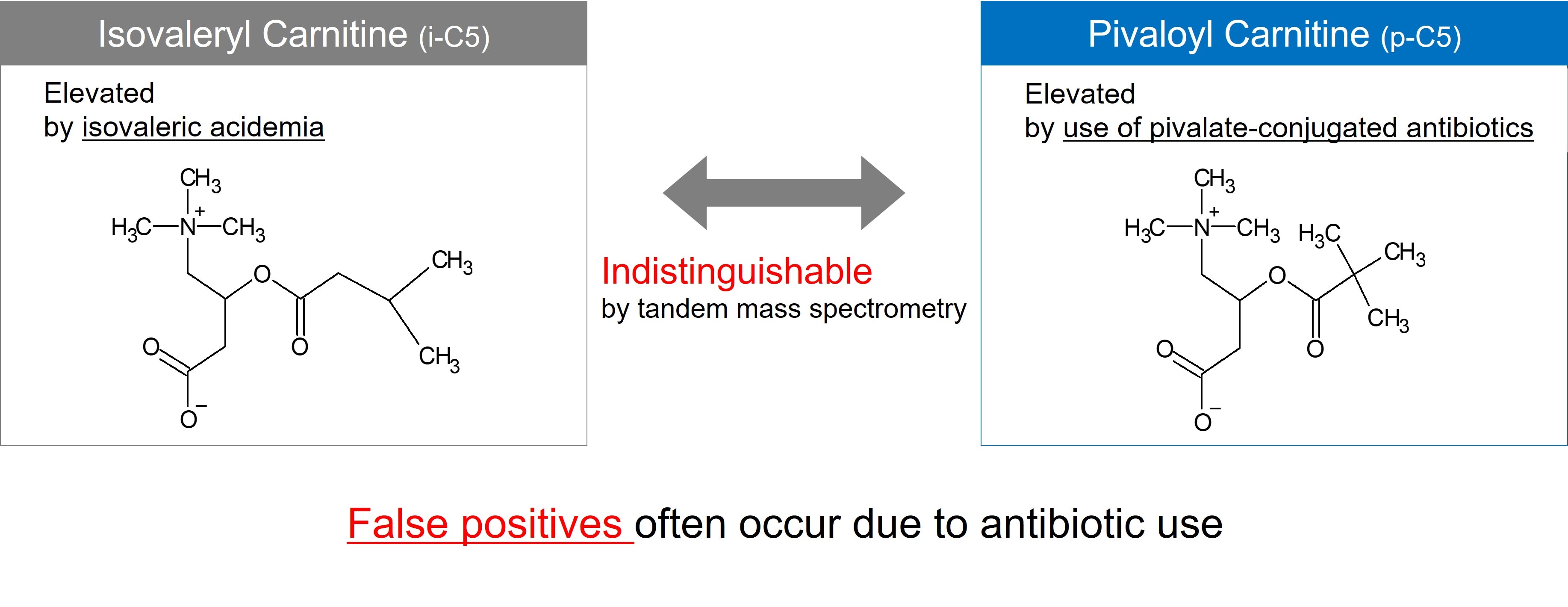
Eliminating False Positives in a Single Step
Analysis by tandem mass spectrometry breaks down an ionized substance and measures the masses of its degradation products. This collaborative research has shown that isovaleryl carnitine derived from isovaleric acidemia and pivaloyl carnitine derived from antibiotics differ in the ease of their degradation. This difference allows analysts to distinguish between the two compounds based on the ratio of degraded ions and thus prevent false positives (Patent pending for this technique). The new method requires only one additional ion measurement to the current screening method. It can be easily changed even at hospitals and testing facilities that already perform screening and causes no change in screening times.
Shimadzu’s mass spectrometers are used in a wide range of applications other than newborn screening. This technique, based on ion ratios, was originally used for testing pesticide residues in food. Applying it to newborn screening led to the discovery of a new method to prevent false positives.
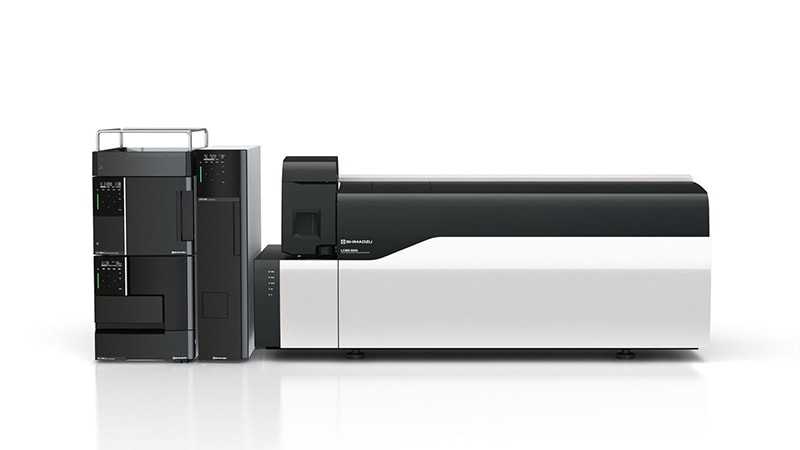
Tandem mass spectrometer used in newborn screening
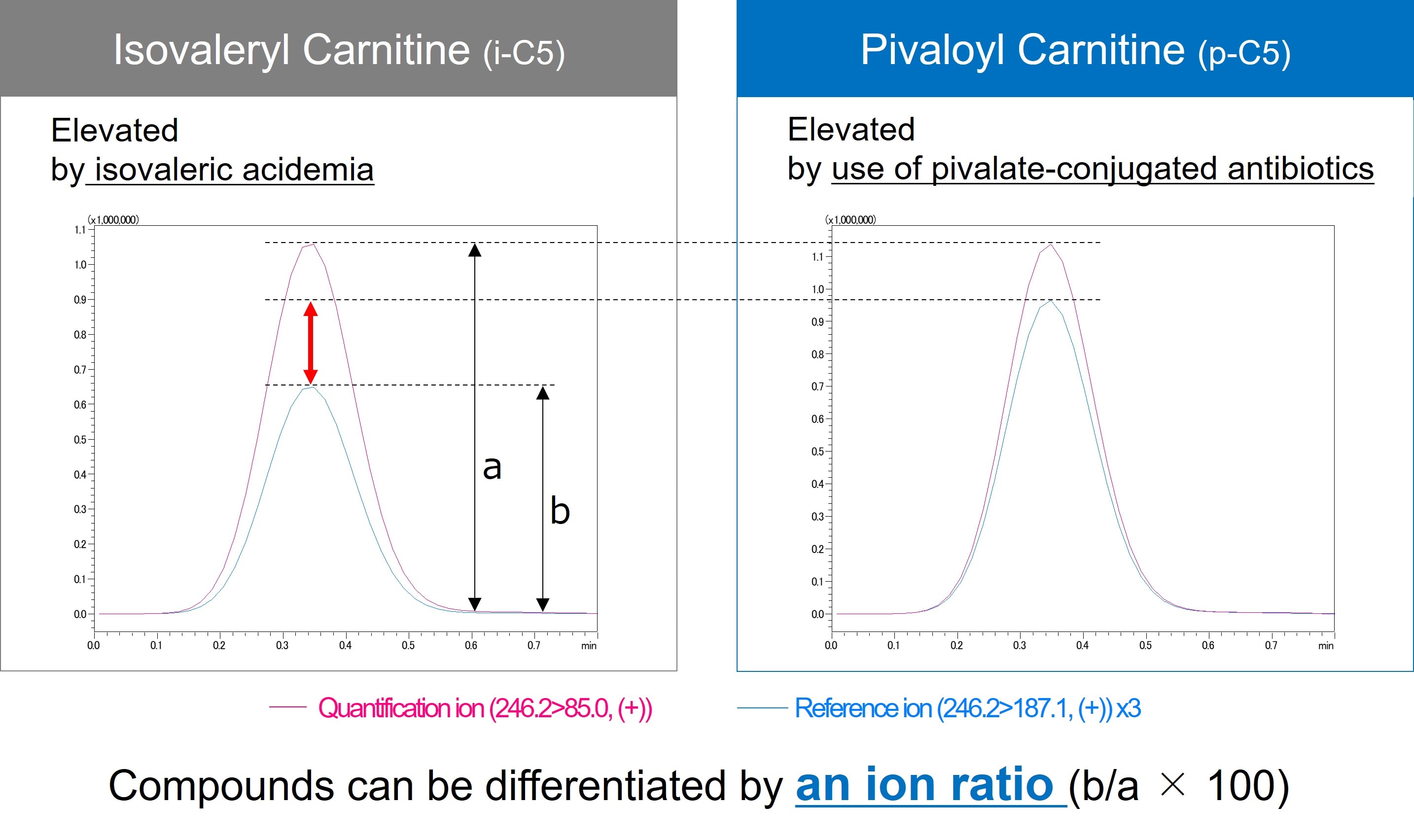
Achieving SDG “Good Health and Well-Being”
This new technique is currently being introduced to hospitals and screening facilities throughout Japan and providing people with more reliable screening tests. Although almost 100 % of babies undergo newborn screening in Japan, there are still many of areas of the world where coverage is low or testing has not yet been introduced. Shimadzu will continue to work towards supporting more accurate screening not only in Japan but around the world. This work will help achieve sustainable development goal (SDG) 3 “Good Health and Well-Being.”
In recent years, the development of treatments has led to the discovery of other diseases that are becoming candidates for screening procedures. We intend to continue contributing to the development of technology used for the conducting research into various diseases.

Helping to achieve sustainable development goals (SDGs)
Message from the Person in Charge of Development for Newborn Screening Method
Takanari Hattori of the MS Business Unit, Life Science Business Department, Analytical & Measuring Instruments Division at Shimadzu helps with research and development for newborn screening. He spoke about Shimadzu’s technology and collaboration with partners.
The technique using the ion ratio value presented here is not a new technique in the world of mass spectrometry and its usefulness in newborn screening is something we would never have discovered alone. It was by way of our collaboration with Shimane University that we learned of the false positive issue and reached the idea of applying this approach to the problem. Through this process, we found the importance of conducting research and development together with experts in diverse fields. Isovaleric acidemia is an organic acidemia that has been reported for the first time in the world by a Japanese researcher and colleagues. It is our dream that these new meaningful methods, originated in Japan, will find widespread use throughout the world in the near future.
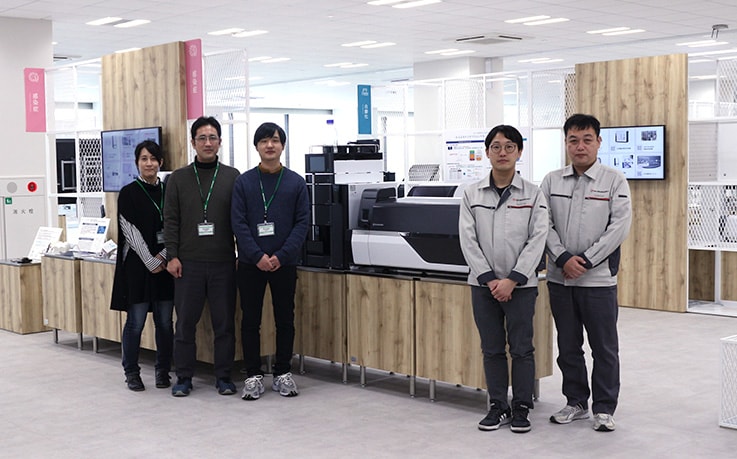
Joint research was conducted by (from far left) Miki Matsui (clinical fellow), Hironori Kobayashi M.D., and Tsubasa Ohguni (clinical laboratory technician) of Shimane University. Takanari Hattori (MS Business Unit) and Tetsuo Iida (Solutions Center of Excellence) of Shimadzu.
- * All the instruments in this article are research-use only (RUO) instruments and not for use in diagnostic procedures. Shimadzu is an analytical equipment provider and in certain regions, including the USA, Shimadzu products may be regulated as for research purposes only. If you have questions on approved use of a Shimadzu device, please contact your regional office.
References
| Website | : | Japanese Society for Neonatal Screening (jsms.gr.jp) |
| Book | : | 「Measuring Molecules: From Cancer Screening to Space Exploration* by Toshihiro Fujii, 2022, Bungeishunju. * English translation is for reference only.“分子をはかる がん検診から宇宙探査まで“ (Original Title in Japanese) |
 Page Title and URL Copied.
Page Title and URL Copied.


